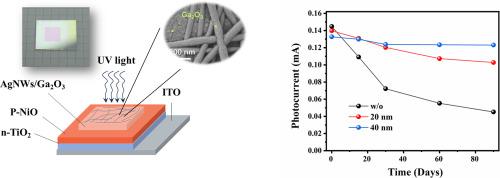Stable, high-performance vertical heterojunction ultraviolet photodetectors with Ga2O3-protected Ag nanowires window electrode
引用次数: 0
Abstract
Large-scale ultraviolet photodetectors are highly promising for detection of weak signals and have the potential for widespread applications in high-tech areas such as aerospace detection and wearable devices. However, the commonly used window electrodes lack transparency to ultraviolet light. Although ultraviolet photodetectors based on Ag nanowires exhibit good response due to their broad transparency range, the sharp interface between the Ag nanowires and the semiconductor renders them extremely unstable. Surface protection is considered to enhance the stability and lifespan of these devices. Our research has revealed that amorphous Ga2O3 can fully encapsulate the surface of Ag nanowires and securely affix it to the NiO film, resulting in a stable performance with a high responsivity of 48 mA W−1 and detectivity of 6.1 × 1011 Jones for 254 nm light. The unpacked device exhibited a stable photocurrent, showing only 6.8% degradation after 3 months in ambient air. Finally, a large-scale (5 cm × 4 cm, with 12 cm2 of active area) ultraviolet photodetector with a Ga2O3-protected Ag nanowire electrode was prepared, which demonstrated a milliamp-level photocurrent under weak ultraviolet illumination that can be directly read by a conventional multimeter in practical scenarios, indicating the promising prospects of this device for future commercial applications.

稳定,高性能的垂直异质结紫外光电探测器与ga2o3保护银纳米线窗口电极
大型紫外光电探测器在微弱信号检测方面具有很高的应用前景,在航空航天探测和可穿戴设备等高科技领域具有广泛应用的潜力。然而,常用的窗口电极对紫外光缺乏透明度。虽然基于银纳米线的紫外光电探测器由于其宽的透明范围而表现出良好的响应,但银纳米线与半导体之间的尖锐界面使其极不稳定。表面保护被认为可以提高这些设备的稳定性和使用寿命。我们的研究表明,非晶Ga2O3可以完全包裹银纳米线的表面,并将其牢固地附着在NiO薄膜上,从而获得稳定的性能,在254 nm光下具有48 mA W−1的高响应率和6.1 × 1011 Jones的探测率。未包装的器件表现出稳定的光电流,在环境空气中3个月后仅显示6.8%的降解。最后,利用ga2o3保护的银纳米线电极制备了一个大型(5 cm × 4 cm,有效面积为12 cm2)紫外探测器,在弱紫外照射下显示出毫安级的光电流,在实际场景中可通过传统万用表直接读取,表明该器件在未来的商业应用中具有广阔的前景。
本文章由计算机程序翻译,如有差异,请以英文原文为准。
求助全文
约1分钟内获得全文
求助全文

 求助内容:
求助内容: 应助结果提醒方式:
应助结果提醒方式:


